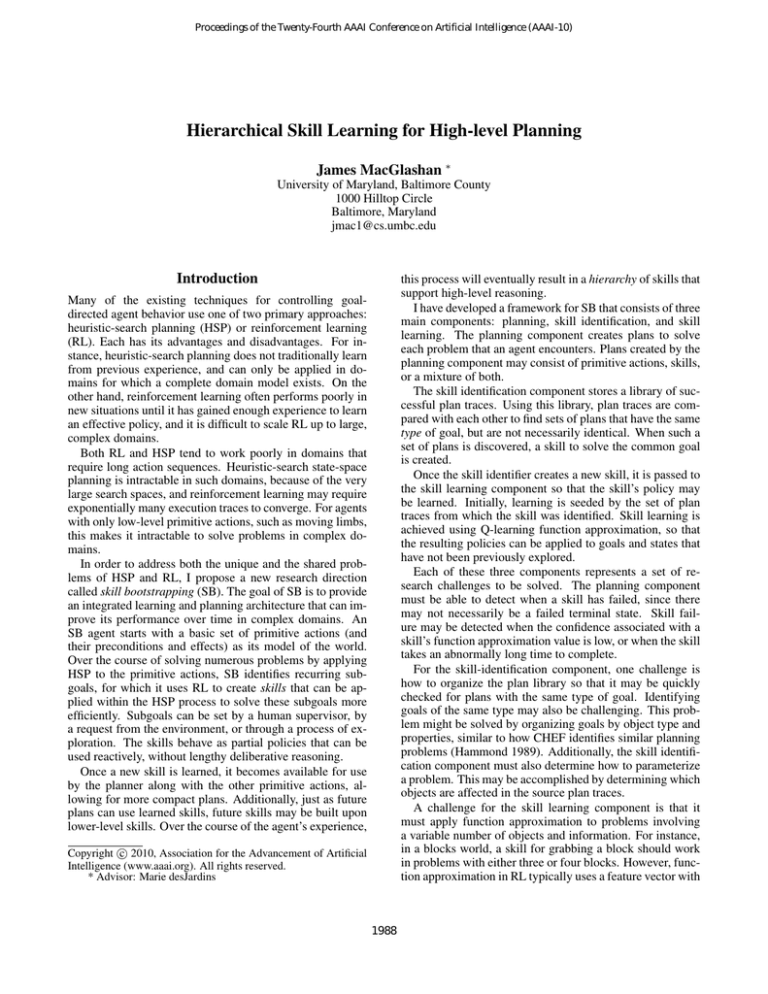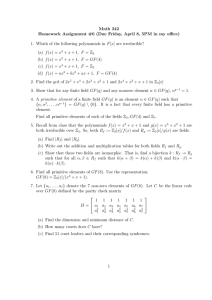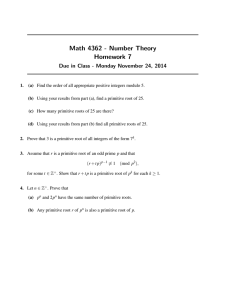
Proceedings of the Twenty-Fourth AAAI Conference on Artificial Intelligence (AAAI-10)
Hierarchical Skill Learning for High-level Planning
James MacGlashan ∗
University of Maryland, Baltimore County
1000 Hilltop Circle
Baltimore, Maryland
jmac1@cs.umbc.edu
Introduction
this process will eventually result in a hierarchy of skills that
support high-level reasoning.
I have developed a framework for SB that consists of three
main components: planning, skill identification, and skill
learning. The planning component creates plans to solve
each problem that an agent encounters. Plans created by the
planning component may consist of primitive actions, skills,
or a mixture of both.
The skill identification component stores a library of successful plan traces. Using this library, plan traces are compared with each other to find sets of plans that have the same
type of goal, but are not necessarily identical. When such a
set of plans is discovered, a skill to solve the common goal
is created.
Once the skill identifier creates a new skill, it is passed to
the skill learning component so that the skill’s policy may
be learned. Initially, learning is seeded by the set of plan
traces from which the skill was identified. Skill learning is
achieved using Q-learning function approximation, so that
the resulting policies can be applied to goals and states that
have not been previously explored.
Each of these three components represents a set of research challenges to be solved. The planning component
must be able to detect when a skill has failed, since there
may not necessarily be a failed terminal state. Skill failure may be detected when the confidence associated with a
skill’s function approximation value is low, or when the skill
takes an abnormally long time to complete.
For the skill-identification component, one challenge is
how to organize the plan library so that it may be quickly
checked for plans with the same type of goal. Identifying
goals of the same type may also be challenging. This problem might be solved by organizing goals by object type and
properties, similar to how CHEF identifies similar planning
problems (Hammond 1989). Additionally, the skill identification component must also determine how to parameterize
a problem. This may be accomplished by determining which
objects are affected in the source plan traces.
A challenge for the skill learning component is that it
must apply function approximation to problems involving
a variable number of objects and information. For instance,
in a blocks world, a skill for grabbing a block should work
in problems with either three or four blocks. However, function approximation in RL typically uses a feature vector with
Many of the existing techniques for controlling goaldirected agent behavior use one of two primary approaches:
heuristic-search planning (HSP) or reinforcement learning
(RL). Each has its advantages and disadvantages. For instance, heuristic-search planning does not traditionally learn
from previous experience, and can only be applied in domains for which a complete domain model exists. On the
other hand, reinforcement learning often performs poorly in
new situations until it has gained enough experience to learn
an effective policy, and it is difficult to scale RL up to large,
complex domains.
Both RL and HSP tend to work poorly in domains that
require long action sequences. Heuristic-search state-space
planning is intractable in such domains, because of the very
large search spaces, and reinforcement learning may require
exponentially many execution traces to converge. For agents
with only low-level primitive actions, such as moving limbs,
this makes it intractable to solve problems in complex domains.
In order to address both the unique and the shared problems of HSP and RL, I propose a new research direction
called skill bootstrapping (SB). The goal of SB is to provide
an integrated learning and planning architecture that can improve its performance over time in complex domains. An
SB agent starts with a basic set of primitive actions (and
their preconditions and effects) as its model of the world.
Over the course of solving numerous problems by applying
HSP to the primitive actions, SB identifies recurring subgoals, for which it uses RL to create skills that can be applied within the HSP process to solve these subgoals more
efficiently. Subgoals can be set by a human supervisor, by
a request from the environment, or through a process of exploration. The skills behave as partial policies that can be
used reactively, without lengthy deliberative reasoning.
Once a new skill is learned, it becomes available for use
by the planner along with the other primitive actions, allowing for more compact plans. Additionally, just as future
plans can use learned skills, future skills may be built upon
lower-level skills. Over the course of the agent’s experience,
c 2010, Association for the Advancement of Artificial
Copyright Intelligence (www.aaai.org). All rights reserved.
* Advisor: Marie desJardins
1988
a fixed dimensionality, which is inflexible to such problem
variability. To resolve this situation, a function approximation technique such as locally weighted averaging (LWA)
may be used, provided that a state similarity metric can be
computed and provided as an input. I am currently investigating a metric that uses techniques from the information
retrieval literature to compute state similarity.
3.
4.
Related Work
5.
The concept of policy control that builds on lower-level action primitives to achieve a goal is not new to agent control. In planning fields, this notion is usually referred to as
macro-operators or macro-actions. Macro-actions are generally constructed as a fixed sequence of primitive actions.
These macro-actions may be constructed by analyzing the
domain (Botea et al. 2005), using genetic algorithms (Newton, Levine, and Fox 2005), or with learning techniques
(Coles and Smith 2007; Coles, Fox, and Smith 2007).
Two key commonalities of these approaches are that
macro-actions consist of fixed sequences of actions, and that
the list must be pruned to avoid large collections of macroactions. The SB approach proposed here differs in that skills
are policy control mechanisms that vary the action sequence
depending on the particular state of the world.
Marthi et al. (2008) propose a hierarchical planner,
AHA*, using high-level actions (HLAs) to specify partial
plans that are refined in the planning process. Planning can
take place at a high level by constructing abstract lookahead
trees. A key difference from the SB approach is that SB creates plans using skills—reactive learned policies for solving
subgoals—whereas AHA* must plan at every step.
Using hierarchies of actions in reinforcement learning
has also been an area of active research. The MaxQ algorithm (Dietterich 2000) used a designed hierarchy of subtasks to efficiently solve more complex problems. Recent
work has focused on automatically identifying the action hierarchy (Jonsson and Barto 2005; Mehta et al. 2008). With
these algorithms, the action hierarchies are fixed structures
that have a defined root structure and are specific to a single problem. With the SB architecture, skills learned in the
SB architecture are not explicitly structured. That is to say,
skills that are referenced by a parent skill do not have to
be invoked by the parent. Rather, any skill can be independently invoked if it is pertinent to the problem at hand.
Other work on forming action abstraction comes from
Simsek and Barto (2007), who examine the graph structure
of problems to identify states that are likely to be important.
The SB architecture differs in that instead of explicit states
being used to identify places for skills, types of goals are
identified that may result in different states that share similar properties and may therefore be parameterized.
6.
objects. Compare results to problems with fixed dimensionality. (5/10).
Planning and replanning with single-layer skills. Compare computational efficiency and plan quality to planning
without skills (5/10).
Seeding skill learning with plan traces. Compare the
learning speed to learning without seeding (8/10).
Learning and planning with hierarchical skills, using hierarchies constructed by a human. Compare efficiency and
plan quality to planning without skill hierarchies (12/10).
Skill identification—finding plans with the same types of
goals, determining parameterization, and action set reduction. Compare results to human constructed skills. (4/11).
References
Botea, A.; Enzenberger, M.; Muller, M.; and Schaeffer, J.
2005. Macro-FF: Improving AI planning with automatically
learned macro-operators. Journal of Artificial Intelligence
Research 24:581–621.
Coles, A., and Smith, A. 2007. MARVIN: A heuristic search
planner with online macro-action learning. Journal of Artificial Intelligence Research 28:119–156.
Coles, A.; Fox, M.; and Smith, A. 2007. Online identification of useful macro-actions for planning. In Proceedings
of the International Conference on Automated Planning and
Scheduling.
Dietterich, T. G. 2000. Hierarchical reinforcement learning
with the MAXQ value function decomposition. Journal of
Artificial Intelligence Research 13:227–303.
Hammond, K. 1989. Case-based planning: Viewing planning as a memory task. Academic Press Professional, Inc.
San Diego, CA, USA.
Jonsson, A., and Barto, A. 2005. A causal approach to hierarchical decomposition of factored MDPs. In ICML ’05:
Proceedings of the 22nd International Conference on Machine Learning, 401–408. New York, NY, USA: ACM.
Marthi, B.; Russell, S.; and Wolfe, J. 2008. Angelic hierarchical planning: Optimal and online algorithms. Technical
Report UCB/EECS-2008-150, EECS Department, University of California, Berkeley.
Mehta, N.; Ray, S.; Tadepalli, P.; and Dietterich, T. 2008.
Automatic discovery and transfer of MAXQ hierarchies. In
Proceedings of the 25th International Conference on Machine Learning, 648–655. ACM New York, NY, USA.
Newton, M.; Levine, J.; and Fox, M. 2005. Genetically
evolved macro-actions in AI planning problems. Proceedings of the 24th UK Planning and Scheduling SIG 163–172.
Simsek, O., and Barto, A. 2007. Betweenness centrality as
a basis for forming skills. Technical report, University of
Massachusetts, Department of Computer Science.
Research Schedule
My research schedule is as follows:
1. Dissertation proposal (5/10).
2. Novel state similarity metric that can be used with parameterized RL in problems with a variable number of
1989






